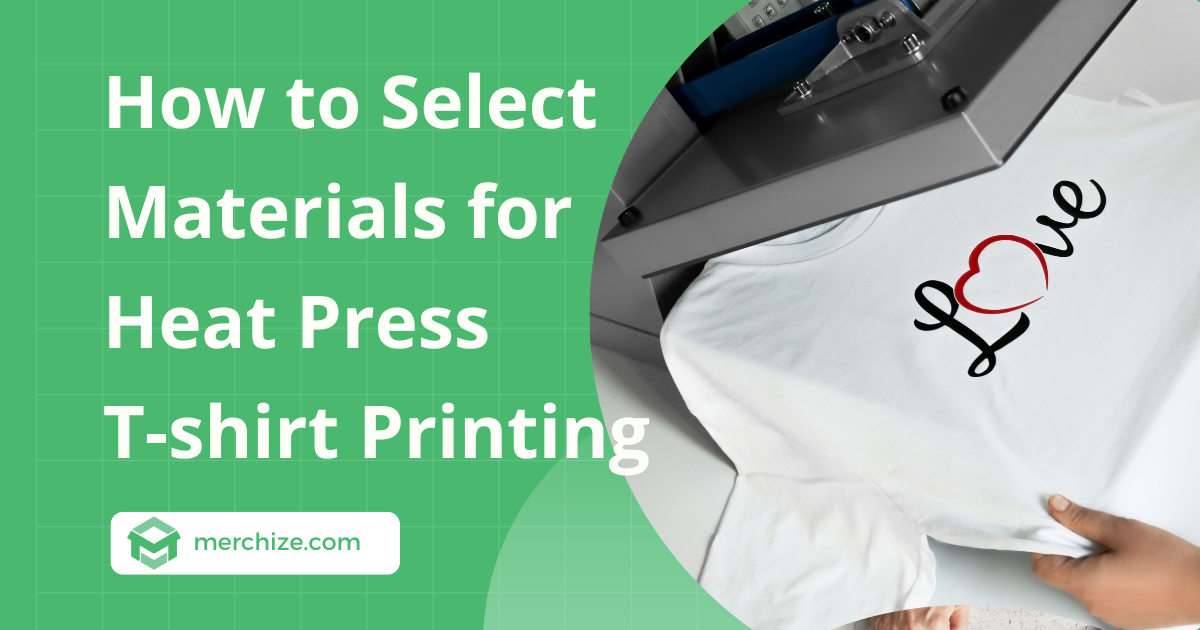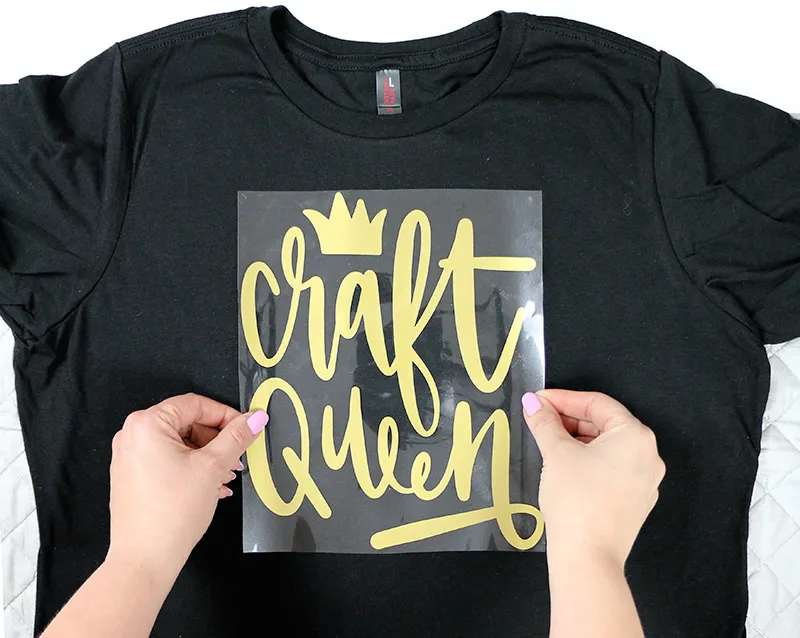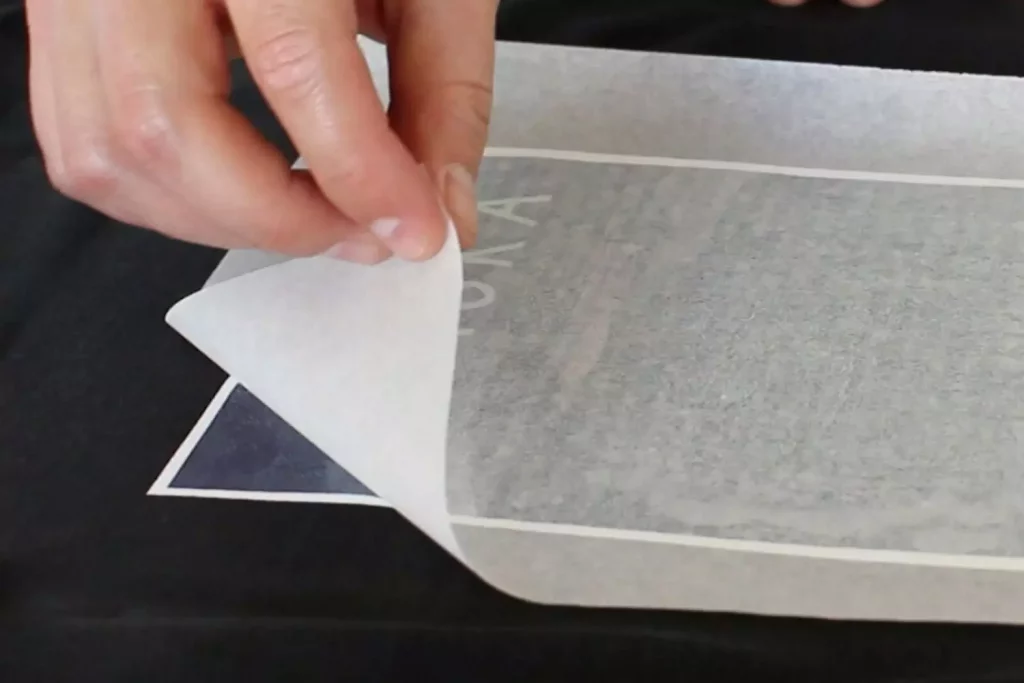For a beginner, heat press printing is the best place to start. It’s easy to do and highly accessible as it only requires a few materials. If you are thinking about printing your own T-shirts, here are all the materials for heat-press T-shirt printing you need to get started.
Transfer paper
With heat press printing, you won’t print your design directly onto the fabric. Instead, transfer paper is used as a medium to transfer printed designs from paper to fabric. Under heat and pressure, the designs will be melted onto the materials, forming new prints.
When it comes to heat press T-shirt printing, choosing the right transfer paper is crucial. Each type of transfer paper brings its own set of benefits and drawbacks. Let’s delve into the specifics of each kind and find the best option for you.
Heat transfer vinyl
Heat transfer vinyl is a top choice for transfer paper in heat press printing. It is made from a special vinyl polymer with heat-activated adhesive, allowing it to stick to the fabric under high temperatures.
The vinyl comes with a clear polyester carrier. The vinyl can be cut into different shapes using the vinyl cutter. After cutting the vinyl, remove the excess vinyl from the polyester carrier and keep the main design for transferring to the fabric later.
This type of transfer paper is easy to use and beginner-friendly. It is suitable for creating simple or lettering graphics. Especially, this printing method offers a inexpensive
The heat transfer vinyl sheets are only available in a single color. If you want to print simple monotone designs, then heat transfer vinyl can be a great option. However, you must layer multiple vinyl sheets to create complicated multi-colored designs, which can be quite tricky and time-consuming.
Advantages:
- Durable and long-lasting.
- Excellent for solid, vibrant colors.
- Works well on a variety of fabrics.
- Budget-friendly, suitable for custom, personalized work.
Disadvantages:
- Limited in creating complex, multi-colored designs
- Time-consuming weeding process.
Heat Transfer Paper
Heat transfer paper is a special paper used to transfer printed designs onto fabrics. Unlike HTV, which is cut and then applied, transfer paper allows you to print full-color images directly onto the paper and then transfer them to your fabric.
The process is quite simple: You can print designs into the heat transfer paper using an inkjet, laser, or white toner printer. Then place this paper onto the fabric and use a heat press to transfer the image as usual.
As it can carry designs in full colors, it only takes one single sheet to transfer your multi-colored designs or even photographic designs. This offers a simple and efficient alternative to HTV when it comes to printing colorful designs.
Based on the color of the fabric, you can select the suitable option: Use light transfer paper for light-colored fabrics and dark transfer paper for dark garments.
Advantages:
- Capable of full-color, photo-quality images.
- Versatile with both light and dark fabrics.
Disadvantages:
- Less durable than HTV; designs may fade or crack over time.
- Requires precise heat press settings to avoid damaging the image.
When choosing compatible heat transfer paper, other than choosing the dark and light options, you must also consider your printer types. Different types of heat transfer papers require different types of transfer paper: Laser transfer paper for laser printers and Inkjet Transfer paper for inkjet printers.
Inkjet Transfer paper
Inkjet transfer paper is a type of heat transfer paper designed specifically for inkjet printers. The process of printing with Inkjet Transfer paper is no different than other types of heat transfer paper.
However, it must be noted that this type of paper is compatible with inkjet printers only. To know whether your printers are inkjet or laser, you can refer to the label on your printer. It is likely that your printer model’s name has already indicated what type of printer it is.
Inkjet printers can print in a full range of colors and replicate images with precise colors and details. This printer along and ink transfer paper makes the best company to turn photos into high-quality, realistic prints.
While you can find inkjet transfer paper for both dark and light garments, don’t expect the prints on dark garments to turn out as well as in the light-colored fabric. Here’s why: For the colors to pop on a dark background, an opaque white coating is added as a base. Otherwise, the ink will look hardly visible in dark garments. The added coating results in thicker layered prints which don’t blend well with the fabric surface.
Advantages:
- High-quality, detailed images.
- Affordable and widely available.
Disadvantages:
- Not as durable; designs can fade or peel after multiple washes.
- Best for light-colored fabrics.
Laser Transfer Paper
Laser transfer paper is a counterpart of inkjet heat transfer paper but for laser printers. Unlike the Inkjet printers which use ink cartridges, laser print runs on toners.
Laser printers are best for printing bold colors and sharp details, ideal for printing simple vector graphics. However, compared with inkjet printers, laser printers are not as great at showing vivid colors or realistic images.
Advantages:
- Produces sharp, clean images.
- Suitable for both light and dark fabrics.
Disadvantages:
- Can be less flexible and may crack over time.
- More expensive than inkjet transfer paper, especially for small print volumes.
Sublimation transfer paper
Sublimation printing is more or less identical to heat transfer printing. Both use a sheet of specialty paper to transfer prints from paper to fabric under heat and pressure.
But what makes sublimation different from the regular heat transfer printing method is its special sublimation ink. Under high temperatures, this ink can transform from solid form to gas which then infuses and becomes one with the fabric surface. When cooled down, the ink sets and returns to the solid form, creating a permanent print on the fabric.
Sublimation printing outdoes all other heat transfer printing methods for making long-lasting, durable prints. Moreover, it also guarantees a high-quality print with vivid colors and intricate details.
Sublimation printing, when combined with cutting and sewing, can give you more room for customizing T-shirt designs. While heat transfer paper can only apply to a small area, mostly the front and the back of a T-shirt, sublimation can print the whole fabric and create all-over print T-shirts.
However, on the downside, sublimation transfer paper is only compatible with polyester fabric. And it also costs a good amount to buy a sublimation printer. This option is much more expensive than other regular heat transfer printing. That’s why it is more suitable for large-quantity printing. If you have a small business or just want to print T-shirts as a hobby, then the regular heat transfer paper is more than enough.
>>> Read more: Sublimation Shirts: Secrets to Creating Eye-Catching Tees
Advantages:
- Extremely durable; designs won’t crack, peel, or fade.
- Vivid, permanent colors.
Disadvantages:
- Limited to polyester or polyester-coated materials.
- Requires specialized sublimation printer and inks.
Fabric
Besides selecting the right type of heat transfer paper, you must also put thought into choosing the suitable fabric materials to place your print designs.
While heat press printing can apply to a wide range of materials and fabrics, only a few are frequently used in making T-shirts. Here are some of the most popular fabric types for heat press printing on T-shirts.
100% cotton
Cotton is the most popular choice for T-shirt heat press printing. Thanks to its absorbent nature, this material works wonders with the heat-activated factors used in heat transfer ink. As a result, the prints can bond well with the fabric, creating durable prints that won’t easily peel off over time.
Beyond its recognized compatibility with heat press printing method, this material is a favorable material for T-shirt printing in general, all thanks to its outstanding qualities.
- Breathability and comfort: Cotton is a natural, breathable fabric that allows air and moisture to pass through, keeping the wearer comfortable. This is particularly important for t-shirts, as the garments need to be comfortable to wear, even with a printed design.
- Versatility: Cotton is a widely available and affordable fabric, making it a popular choice for t-shirt printing. It can be found in a variety of weights, textures, and colors, allowing for a wide range of design possibilities.
100% polyester
Even though it is not as popular in the T-shirt section as cotton fabric, polyester is quite dominant in the sportswear market.
Even though it is super durable, this synthetic fabric is very delicate under high temperatures. That’s why you should be selective when it comes to choosing heat printing methods to apply to polyester. Dye sublimation printing is considered the best choice for printing on polyester T-shirts. With other heat press printing options, never set the temperature too high, or else you might risk damaging the quality of the fabric.
Here are a few benefits of polyester:
- Durability: Polyester is well-known for its durability. This synthetic fabric can withstand all the wear and tear without losing its integrity, making it the ideal choice for sportswear.
- Wrinkle resistance: Another favorable trait of polyester is its low maintenance. The fabric is wrinkle-free, requiring no ironing or careful attention but still looks neat and polished anytime.
- Vibrant prints: Especially when it is sublimated, polyester fabrics can hold the dyes and pigments very well. The prints on polyester appear more vibrant, bold, and realistic than other materials.
- Cost effectiveness: Polyester is relatively inexpensive, making it a cost-effective option for mass-producing printed t-shirts.
Cotton-polyester blends
If you are seeking a material that can provide the best of both worlds: polyester’s resilience and cotton’s comfort, cotton-polyester blends are the choice for you.
As it is partially made from synthetic material, you should also pay attention to time and temperature settings when heat press printing such materials.
- Durability: Inheriting the strength of polyester, cotton-polyester blends are also built to last. They can withstand heavy use and repeated washes. Moreover, the polyester fibers reinforce the fabric, preventing it from shrinking, stretching, or losing its shape, which is a common issue with 100% cotton garments.
- Comfort: Cotton-polyester blends retain the soft, breathable qualities of cotton which make the T-shirt feel good against the skin. On the other hand, the polyester adds a slight stretch and smooth texture, enhancing overall comfort. This blend results in a fabric that is soft yet resilient, perfect for everyday wear.
- Versatility: From a technical standpoint, cotton-polyester blends make an ideal material for manufacturing and printing. This super versatile fabric can be adopted into different styles, designs, and uses. Moreover, they are suitable for various printing techniques, from regular DTG to heat press printing.
Tri-blend fabrics
If you combine polyester, cotton, and rayon, you will get what is called tri-blend fabric. This type of fabric is like an upgraded version of the cotton-polyester blend. Along with all the qualities that cotton and polyesters provide, tri-blends also feature some distinctive features derived from rayon fibers:
- Softness: Rayon is soft like silk. Adding rayon to the mix gives the material a softer and supple hand feel, making it comfortable to wear, particularly for a long period of time.
- Flowiness: The softer and flowy tri-blend results in a more drapey and form-fitting T-shirt. Such material creates a more flattering and relaxed T-shirt silhouette.
- Stretch and flexibility: Triblends are also more stretchable compared to pure cotton or polyester fabric. This allows a more comfortable fit, as well as a wider range of movement.
However, this garment can be quite delicate, especially under high temperatures. When heat press printing tri-blend fabrics, you must handle the fabric with extra attention and adjust the temperature setting to low.
For the prints to stick to the fabrics without exposing them to high temperatures, it’s recommended to add a lower heating element underside of the garment. Even if the high heat causes any scorch to the fabric, it would be on the inside of the T-shirt.
>> Read more: Best Shirt Material: How to Choose the Right T-Shirt Fabric?
T-shirt heat press machine
Choosing a T-shirt printer that fits your needs and budget is one of the most important factors to consider when getting into this printing business.
Cricut EasyPress
Cricut EasyPress is a compact, portable heat press designed for beginners and small-scale creators.
If you are just starting out and want to experiment with printing on t-shirts, the Cricut EasyPress is an excellent choice. Its lightweight design makes it easy to move around, and it works well for simple heat transfer vinyl (HTV) projects and basic sublimation paper transfers. For a beginner, this is more than enough to practice and refine your skills.
How it works:
- Place the press directly on the sublimation paper or vinyl positioned on the fabric
- Apply steady pressure for a set amount of time
- Adjust temperature and time using the digital control panel, depending on the fabric type
Advantages:
- Easy to use: Perfect for beginners thanks to its simple setup and step-by-step guidance through the Cricut Heat app
- Portable: Lightweight and easy to store, ideal for home use or small spaces
- Affordable: Costs less than industrial machines, making it budget-friendly for hobbyists
Drawbacks:
- Limited size: Small pressing area, not suitable for large or full-coverage prints
- Manual pressing: Requires hand pressure, which can lead to uneven results if not applied consistently
Price range: 87 to 249.99 USD
Best for: DIY enthusiasts
Clamshell Heat Press Machine
Clamshell Heat Press is a traditional heat press widely favoured by both beginners and professional printers for its versatility and efficiency. Its hinged design allows the top platen to open and close like a clamshell, saving space while enabling fast operation.
If you want an easy-to-use machine that works with cotton, blends, and some polyester sublimation, the Clamshell Heat Press is a great choice.
How it works:
- Lift the heated top platen to place the garment and transfer sheet
- Lower the platen to apply heat and pressure
- Adjust pressure and time through the digital control panel to suit HTV, heat transfer paper, and some sublimation materials
Advantages:
- Space-saving: Compact design suitable for small work areas
- Fast operation: Easy to open and close, helping speed up production
- Versatile: Works well with a variety of materials and fabrics, from cotton to blends
Drawbacks:
- Limited access to pressing area: The hinged design can make alignment more challenging with large garments or thick fabrics
- Burn risk: The heated surface is exposed when open, so careful handling is required
Price range: 209 to 2,959 USD
Best for: Small to medium businesses or individuals seeking a balance between cost and performance
Sublimation Heat Press (Dye-sublimation)
Sublimation Heat Press is a specialized heat press for dye-sublimation printing. It uses sublimation ink to create vibrant, long-lasting designs on polyester or polyester-coated fabrics.
This machine is ideal for printing sportswear, uniforms, or full-coverage designs with bright colors. However, it requires a larger investment since it must be used with a specialized sublimation printer and ink.
How it works:
- Place the sublimation transfer paper with the printed design onto the polyester fabric
- The machine heats the paper, causing the ink to vaporize and bond directly with the fabric fibers
- Once cooled, the image becomes part of the fabric and won’t peel or fade
Advantages:
- High image quality: Produces sharp, vibrant, and durable prints
- Full surface printing: Perfect for all-over garment designs
- Excellent durability: Prints do not fade or crack over time
Drawbacks:
- Material limit: Only works on polyester or polyester-coated surfaces
- Higher cost: Requires a sublimation printer and ink, not ideal for beginners with a tight budget
Price range: 580 to 1,025 USD
Best for: Businesses or sellers with large order volumes
Conclusion
Heat press printing is a highly versatile printing technique. To make the most of this printing option, you must select the right material, from the fabric to the transfer paper. Depending on the purpose of your T-shirt designs, you can make your design on what fabric or transfer paper to use. Hope that with these tips, you can start your heat press T-shirt printing journey with no hassle!
FAQs
1. Heat pressing 101
Heat pressing is the process of using high heat and pressure for a set time to transfer designs from vinyl, transfer paper, or sublimation ink onto shirts. When you choose the right material, temperature, time, and pressure, the print will be durable and sharp.
2. Best materials for heat T-shirt printing
Heat transfer vinyl (HTV) works well for simple designs and is easy to use. Transfer paper (inkjet or laser) is suitable for quick prints or when you don’t have a cutting machine. Sublimation is ideal for polyester, producing vibrant and long-lasting colors.
3. Tips for heat press printing on shirts
Always pre-press shirts for a few seconds to remove moisture and wrinkles. Align your design using the collar or a ruler. Test on a cheap sample first to adjust heat and pressure. Store your materials in a dry place to avoid printing errors.








